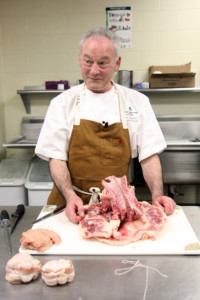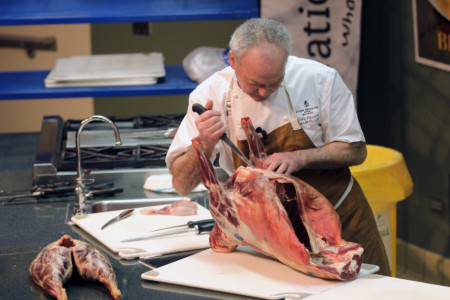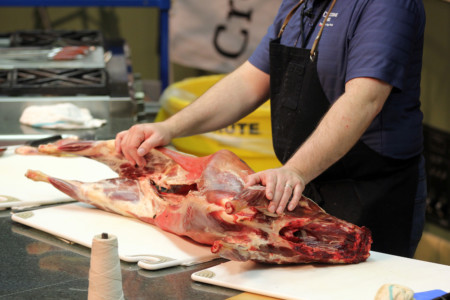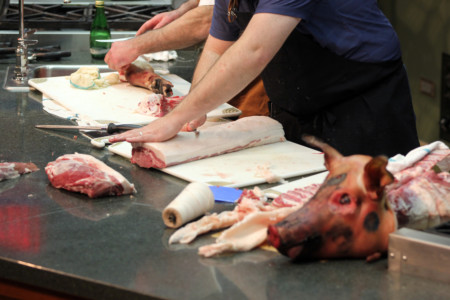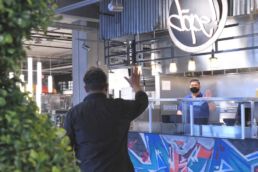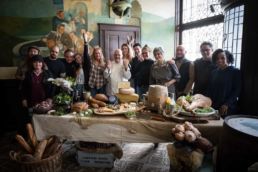words GRACE YEK, CCC, MS | photography DEOGRACIAS LERMA
In an auditorium of more than fifty chefs, Marc Pauvert’s knife glides quietly between bone and flesh, like water effortlessly finding its path. He holds and strokes the side of hog with his fingers as he cuts—always feeling, always listening. In that moment, he is fully immersed and lost to the world.

“It’s so [sensuous],” Michael Sullivan, his co-instructor, explains. “You use all your senses when you butcher. It’s the way your hand is touching the meat—you can feel the meat separating.”
If butchery is a lost art, then Sullivan and Pauvert symbolize hope for bringing it back. Together, they teach an intense two-day butchery and charcuterie workshop called, simply, Cure Camp.
Butcher and chef Sullivan led the butchery and charcuterie program at Blackberry Farm for ten years prior to joining Creekstone Farms in 2015. His training includes staging for the venerable Stanley Lobel, butcher and president of Lobel’s of New York.
Sullivan’s unforgiving schedule at Blackberry Farm did not allow him to accommodate many aspiring interns. Perhaps this, in part, now fuels his mission to teach this dying art form.
“What good is all this knowledge if it dies in your head?” Sullivan asks.

Originally from Chamonix in the French Alps, Sullivan’s partner, Pauvert, started his butchery apprenticeship at age fourteen. “I was bad at school,” he says with a chuckle. “My mother said, ‘What do you want to do?’ I chose butchery.”
After earning the rigorous master butcher certification at a mere eighteen years old, Pauvert went on to work in butcher shops in Paris and around the world, in places like Morocco and Saudi Arabia. Today, he leads the butchery operations at Four Seasons Hotel Baltimore.
Pauvert teaches through his hands, a pair of living apparatus that are permanently honed from the many years of butchery. His European training comes through in his practice of seam butchery, a technique that breaks the animal down along the seams of different muscle groups. It’s a stark contrast to the American practice of butchery where a band saw is used to cut through the meat, yielding cuts with mixed muscle groups and embedded silver skin, or tough fascia.
Seam butchery preserves whole groups of muscles, which call for different preparations. It also minimizes waste, often allowing the meat to be removed clean from the bone. It’s a technique where the animal tells the butcher where to cut.
“Can you hear my knife rapping the bone?” Pauvert says, as he curves the trajectory of his knife along the seam. “Listen to the knife hit the bone.”

As Pauvert’s knife travels, Sullivan diligently interprets and explains the scene. He walks around with his hands cupping a whole pig’s head to make the point of using all parts of the animal—in this case, using the head to make headcheese and stock. “Whole-animal butchery only makes sense if you’re using the whole animal,” he asserts.
In part, Sullivan points to this country’s insulated culture for killing the art of butchery. “People only want steaks. In Europe, there’s so much respect for the whole animal,” he says, referring to the everyday consumption of offal. “It’s hard work here, you have to sell it.”
Sullivan carries over the whole-animal ethos to the curing of meats in charcuterie. “You want to honor the farmer and the terroir from which the animal came,” he says. “We give honor to the animal, adding salt, time, and love to continue its life.”
“It used to be a way of extending shelf life,” he continues, noting how charcuterie has evolved. “But now, it’s a way of developing and concentrating flavor.”
Sullivan maintains high quality charcuterie could only be possible with “amazing meat.” The need for a skillful butcher who can render good cuts is also imperative.
For too long, Pauvert thinks respect has eluded the butcher, whose contribution gets lost between the farmer and the chef. “But now the chef finds out it makes economic sense to have a good butcher.”

He gives the example of a 250-pound hog, averaging a 4-pound liver. “I can make 4 pate terrines, and at 15 servings per terrine, I get 60 servings,” he explains. “At $15 a plate for a total of $900, the liver pays for the whole pig.”
Respect for Pauvert is unmistakable as all eyes stay on him, witnessing this dying art form. No one looks away as he deftly removes the entire rib cage of a duck while keeping the skin pristinely intact for the subsequent preparation of galantine.
In another demonstration, Pauvert breaks down a whole chicken—two legs, two wings, two split breasts—in a breathless fifteen seconds. As he fashions chicken cordon bleu with Gruyère cheese, bacon, and prosciutto, he bundles the chicken breasts with thin butcher’s twine and artfully teases a floral contour out of each bundle.
“Butchery in France is an art,” he says. “People buy with their eyes.”
It’s perhaps ironic that for such an accomplished butcher Pauvert remains very unforgiving of himself. “When I do a bad job, I scream at myself, ‘What are you doing?’” he says, raising his voice and slamming hard on the table to make the point. “I cannot do a bad job.”
For Pauvert, butchery transcends art; it verges on a spiritual experience. When he hits his stride, he grows quiet and looks transported. He finally reveals, “I think of France.”
Note: Creekstone Farms’ Cure Camp is a two-day butchery and charcuterie workshop geared toward an advanced chef audience. Cure Camp made a stop in Cincinnati on March 20-21, 2017. The event was free through sponsorship by Sotto, Creation Gardens, and Cincinnati State Midwest Culinary Institute. Danny Combs, chef de cuisine at Sotto, and Danny Bungenstock, chef instructor at Cincinnati State College, organized the event in Cincinnati.


